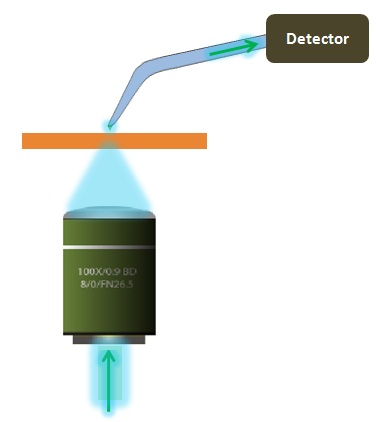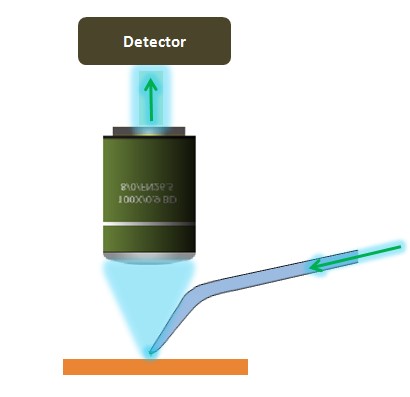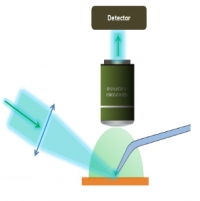The Cryoview enables measurements of low temperature electrical, optical, magnetic, and thermal properties of materials fully integrated with near-field and far-field optics, Raman, and fluorescence spectroscopies. It opens new avenues for multiprobe measurements including transport properties of materials at temperatures as low as 10K. The CryoView is an award-winning, must-have tool especially suited to probe 2D materials such as graphene, MoS2, BN, TaS2, NBSe2, WS2, HfO2, metamaterials, and metasurfaces as well as other functional material materials such as Si, carbon nanotubes, III-V semiconductors, and quantum dots.

Many of these materials with their associated properties require a wide variety of physical phenomena that must be applied for a full functional understanding. Examples include: nanometric photoconductivity and other optically related properties, nano electrical characteristics (electronic mobility, charge carriers, etc.), thermal properties, and quantum Hall effect. All these phenomena can be investigated using apertured and scattering modes of NSOM and sSNOM and/or Kelvin probe, which are often coupled with Raman chemical characterization and other optical spectroscopies such as photoluminescence.
Key Features

True AFM with Multiple Advanced SPM Functionalities
Up to 4 probes are possible with the CryoView MP where each probe is capable of all SPM modes including magnetic force microscopy (MFM), electrostatic force microscopy (EFM), and Kelvin probe force microscopy (KPFM) for low temperature operation. These advanced modes are possible in addition to topography and morphology with non contact AFM based methods. Non-contact AFM is made possible through tuning fork actuation where the probe is mounted onto the tuning fork, and feedback is maintained by monitoring either the amplitude, phase or frequency. Compatible with any SPM probe including cantilevered probes; probes can be mounted onto the tuning fork for a full range of SPM capabilities at low temperature. All AFM and STM probes are compatible with the CryoView MP.
Low Temperature and High Vacuum
Low temperature cooling is very fast down to temperatures of 10K. The Cryoview does not need an immersion cryostat for cooling, thus enabling an accelerated cooling process. Additionally, there is no vibration during scanning with the use of ion pumps. The Cryoview is encased in a vacuum chamber that can hold pressures down to 10^-8 torr.
MultiProbe Capability
Upto 3 probes can be modularly added. 2-probe system seen below:

Complete Optical Integration with NSOM or Raman
 All probes in the CryoView MP have unobstructed access from above and below enabling full integration with optical microscopes and optical methods at low temperature. With selection of correct probes, AFM-Raman or NSOM can be performed with any of the probes in the system.
All probes in the CryoView MP have unobstructed access from above and below enabling full integration with optical microscopes and optical methods at low temperature. With selection of correct probes, AFM-Raman or NSOM can be performed with any of the probes in the system.
Low Temperature Transport Studies
The multiprobe design in the CryoView MP is uniquely suited for electrical, thermal, and optical transport studies. One probe can be used to excite or optically pump the sample, while a second probe can detect the results of the excitation. A third and fourth probe can be then be used for further study and characterization. Numerous examples of transport studies that can be studied with our multiprobe system can be found here including electrical transport on graphene with simultaneous Raman or simultaneous reading and writing of protein features on a sample.
Integrated Magnet Modulation (Optional)
- The Cryoview MP offers the option to integrate a magnet of up to 1.4 Tesla from below for experiments requiring magnetic modulation.
- Choice of 2T superconducting cryogen free magnet from the bottom with full separation of vibration of the cryogen free superconducting mechanism.
- Ability to have a second probe with a scannable magnet from above the sample for variable magnetic field lines from above.
- Choice of cheaper, non-superconducting solution upto 1.4 Tesla
Optical Integration
- Completely open optical architecture with a transparent NanoToolKit of Probes and an SPM head capable of full integration with optical microscopes including upright, inverted, dual microscope configuration.
- Suitable for transparent and opaque samples
- Compatible with standard optical microscope configurations
- Standard inverted microscope with 22 mm working distance objective 50x with a numerical aperture of 0.42 from below
- Standard upright optical microscope with 50x0.42 numerical aperture objective with a 22 mm working distance lens from above
- Integrate with femtosecond lasers on the same optical table without intervening optical fibers.
Seen below: (L) CV integration with upright microscope. (R) CV integration with dual upright and inverted microscopes


Vibration Isolation
- 0.2nm peak to peak obtained with AFM imaging of HOPG sample with atomic steps
- No vibration during scanning with the use of ion pumps
- Motionless low vibration cooling with cryogen and the ability for variable temperature
- Vertical and horizontal natural frequency is load dependent.
- 1/2 Hz or less can be achieved at or near the upper limits of the payload range
- Acoustic enclosure

NSOM
True Collection NSOM
 Collection mode NSOM is depicted in the schematic to the right, where the light illuminates the sample, and then is collected through the NSOM probe by a detector. The CryoView offers both tip scanning and a sample scanning stage with upto three probes that can scan independently and simultaneously. A sample scanning stage enables easy and rapid alignment of the sample relative to the illumination source and ensures that the microscope optics are independent of the AFM scanner. This instrumentation design is ideal for true collection mode NSOM.
Collection mode NSOM is depicted in the schematic to the right, where the light illuminates the sample, and then is collected through the NSOM probe by a detector. The CryoView offers both tip scanning and a sample scanning stage with upto three probes that can scan independently and simultaneously. A sample scanning stage enables easy and rapid alignment of the sample relative to the illumination source and ensures that the microscope optics are independent of the AFM scanner. This instrumentation design is ideal for true collection mode NSOM.
Cantilevered Probes for the Best NSOM Performance
Nanonics is the global pioneer in glass probe manufacturing and has developed a whole suite of probes for all your NSOM applications in our Nanotoolkit that are compatible with the Multiview 2000 system, featuring glass cantilevered normal force probes for high-quality imaging of all samples, efficient apertureless NSOM probes, fiber probes with metallic nanoparticles in tip, metallized probes, and straight probes also available for shear force feedback measurements.
Flexible Optical Access for NSOM
This enables total flexibility in your NSOM setup, as the CryoView can be integrated with any optical microscope. Additionally, total optical access to sample and probe position from above is possible since the cantilever probe/scanner assembly does not obscure access.
True Reflection NSOM
 In true reflection mode, light is introduced via the NSOM probe, and then collected by a detector above the probe as shown in the schematic below. True Reflection mode NSOM is possible on the CryoView due to the use of "transparent", cantilevered probes. Furthermore, the design of the Multiview series separates the excitation and collection paths so that they don't affect each other, thus enabling true reflection mode NSOM measurements to be conducted. Other designs that take advantage of straight probes or apertured Si probes are significantly more challenging for true reflection mode.
In true reflection mode, light is introduced via the NSOM probe, and then collected by a detector above the probe as shown in the schematic below. True Reflection mode NSOM is possible on the CryoView due to the use of "transparent", cantilevered probes. Furthermore, the design of the Multiview series separates the excitation and collection paths so that they don't affect each other, thus enabling true reflection mode NSOM measurements to be conducted. Other designs that take advantage of straight probes or apertured Si probes are significantly more challenging for true reflection mode.
Dual Configuration for Optical Pump/Probe NSOM Experiments
Optical pump/probe experiments can now be performed using one probe to optically pump while the other probe measures the optical output in a variety of configurations. In the example below using two cantilever, near-field optical probes with exposed tips, light is injected through one probe and is guided through the sample which is a fiber. With the second probe in place, this injected light can be collected and analyzed both spatially and temporally. In this image two NSOM probes are seen in AFM contact with the input and output of the fiber waveguide.

Click below to learn more about the varous modes of NSOM.
Raman
Tuning Fork Feedback without Raman Laser Interference
 The CryoView is equipped with a laser-free feedback method called normal force tuning fork feedback. For example, many SPM laser-based feedback systems employ red lasers, which would then interfere with the Raman emission in the redo from the sample. The CryoView MP eliminates all problems associated with optical interference in your Raman experiments.
The CryoView is equipped with a laser-free feedback method called normal force tuning fork feedback. For example, many SPM laser-based feedback systems employ red lasers, which would then interfere with the Raman emission in the redo from the sample. The CryoView MP eliminates all problems associated with optical interference in your Raman experiments.
Built for TERS Operation
- Quick and easy TERS hotspot detection - Combined tip and sample scanning stage within the same scanning system provides accurate positioning of the probe at the ideal location for TERS with respect to the focused laser spot. Tip can be positioned within the center of the Raman hotspot for optimal TERS signal detection.
- Sample can be imaged with the sample scanning piezo stage without losing the TERS hotspot position.
- All modes of TERS including STM and AFM-TERS with easy interchangeability are available. Thus the same probe (either conducting or with a conductive coating for STM-based feedback) can operate in AFM feedback using tuning fork based feedback for TERS measurements, and then it can be switched to tunneling based feedback for TERS operation in gap mode.
- TERS on non-conducting surfaces.
- Availability of the upper XYZ piezo scanner for the tip scanning enables 3 point TERS measurements for comparing the difference between enhanced and non-enhanced spectra and extracting new information.
Open Optical Architecture for Multi-axis Raman Configuration
The CryoView can be combined with either an upright, inverted, or a dual microscope (combined upright and inverted) where the same SPM head is used for either microscope configurations. The CryoView with dual microscope can be integrated with many types of the Raman spectrometers, and with no intervening optical fibers. Such a system enables Raman and TERS measurements to be conducted in upright, inverted, and side-illumination microscope configurations.
Effortless AFM-Raman Integration
No modification of the Raman path is necessary to accomodate the SPM tip and head. This design results in a natural and straightforward Raman path for integration without the need for tilting or bending the Raman path to accomodate the SPM. Furthermore, transparent optical AFM probes provide a completely transparent optical system. Both reflection Raman and transmission Raman are standard on the CryoView. Side illumination is also available. This system is compatible with 50x, NA 0.42 optical objective from the top and from the bottom.
Best TERS Probes on the Market (Exclusively for Nanonics Users)
- Transparent TERS probes with gold ball embedded inside the glass
- STM and non-STM TERS probes
- Gold and silver-coated AFM probes
- Nanonics TERS probes are supplied bent in the range of 45-60 degrees, the optimal angle for TERS excitation
Autofocus for Superior Raman Resolution

Background-free Raman Measurements
- Laser-free tuning fork feedback method (replaces laser-based feedback)
- Optically transparent cantilever glass probes
Contact a Nanonics Specialist to Discuss Your Specific Needs
We are happy to answer all questions and inquiries
Videos
Microscope Rotation
Multiprobe Vacuum Chamber - MV4000
Four Independently Controlled Probes
Environmental Control Chambers for Scanned Probe Microscopy



